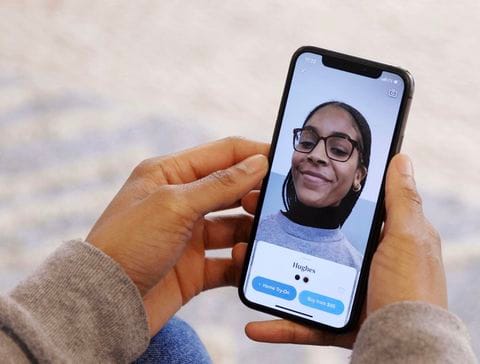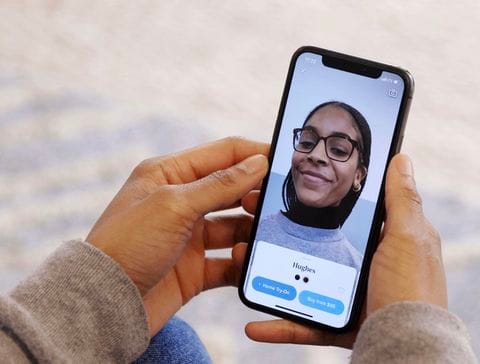
(Warby Parker) ((Photo courtesy of Warby Parker) )
Way back in 2010, Warby Parker’s Home Try-On program changed the way people buy glasses.
Its secret? Creating a casual business transaction that felt more like commitment-free dating. The idea was simple: Customers could select multiple new frames online before testing them out for five days in person. Once the test drive was up, customers could commit to a pair of glasses after returning the frames by mail.
Nearly a decade and hundreds of millions in revenue later, the company has announced a more high-tech and expedited version of the same process. On Monday, Warby Parker unveiled a tool that allows customers to try on frames in its app using augmented reality, a technology that superimposes computer-generated images onto real-world imagery. For example: your face on camera with various pairs of virtual Warby Parker glasses.
The company is not the first to allow customers to try on frames virtually, as the Verge noted, but it remains unique “by actually rendering the glasses in a live, 3-D preview on your face with augmented reality.”
The app uses the phone’s camera and Apple’s Face ID, which uses 30,000 invisible dots and an infrared image to create a precise copy of a customer’s face using measurements from a proprietary method the company calls “unique placement.” A photo-sharing option allows customers to enlist feedback from friends and family.
Warby Parker is calling the new tool Virtual Try-On.
“Shopping for glasses is challenging for most people,” Warby Parker co-founder and co-chief executive Dave Gilboa said in a statement emailed to The Washington Post. “It’s one of the only products you wear on your face, and slight differences in sizing or shape can have a dramatic effect on whether a frame fits well or not.”
“Virtual Try-On really changes the way you can shop for glasses — especially for customers who don’t live close to a store — and it’s inherently enjoyable to use,” the statement added.
[The Weather Channel uses virtual reality to preview Winter Storm Harper]
Testing products virtually could be a way for a company to overcome the challenge of evolving shopping habits. Increasingly, customers see bricks-and-mortar stores less as shopping destinations and more as the final step in a multipart transaction that begins online, according to Michelle Tinsley, director of mobility and secure payments in the retail solutions division at Intel.
“When you take that effort, you go into the store, you actually want to complete [the transaction], so you’re going to be irritated or mad if you drove all the way to the store only to be forced back online,” Tinsley told Racked in 2017. “We found that people only go into a dressing room once and get undressed once. If they can’t get the right size and the right fit and they leave the dressing room, it’s very hard to get them to go back into the dressing room a second time.”
In a video posted on Warby Parker’s Twitter feed, a customer is seen selecting a frame and then swiping through variations of that frame using the company’s app. With each swipe, a new virtual pair of glasses is immediately superimposed on the customer’s face, which is being filmed in real time using her phone’s camera. When the customer turns her head, the virtual glasses stay on her face, shifting with the movements of her body.
Warby Parker isn’t the first company to help customers shop using augmented reality. In 2017, the start-up Avametric unveiled an augmented shopping app that lets customers try on clothes virtually using an avatar with customizable body types.
The Ikea Place app uses AR technology to allow customers to place pieces of furniture in their homes, according to the company.
“You see the scene as if these objects were real and you can walk around them and interact with them, even leave the room and come back. It’s really magic to experience,” Michael Valdsgaard, the leader of digital transformation at Inter Ikea Systems B.V., said in a statement on the company’s website.

